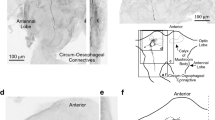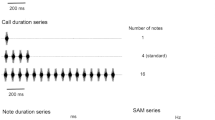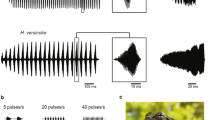Summary
-
1.
Prothoracic auditory interneurons in the primitive orthopteran Cyphoderris monstrosa (Ensifera: Haglidae) were characterized morphologically and physiologically, using intracellular recording and staining.
-
2.
Auditory interneurons with similar morphologies to several classes of identified cells in crickets were discovered. These cell types corresponded to omega, AN1, DN1, and TN1 cells of Gryllidae. Several novel cell types were also discovered, including a second ascending cell with a distinctive morphology, and several descending and T-fibres.
-
3.
Responses of auditory cells had a similar frequency tuning to whole auditory nerve measurements, with all cell types responding maximally to low frequencies (2–4 kHz). This is in contrast to the carrier frequency of the species acoustic signal (12 kHz). There were differences, however, in the relative sensitivities of different interneuron types at the calling song frequency, with ascending and omega cells being more sensitive at this frequency than descending or T-cells.
Similar content being viewed by others
Abbreviations
- BF:
-
best frequency
- pps:
-
pulses per second
References
Alexander RD (1967) Acoustical communication in arthropods. Annu Rev Entomol 12:495–526
Alexander RD (1968) Arthropods. In: Sebeok TA (ed) Animal communication. Indiana University Press, Bloomington, pp 167–216
Ander K (1939) Vergleichend-anatomische und phylogenetische Studien über die Ensifera (Saltatoria). Opusc Entomol Lund Suppl 2
Atkins G, Pollack GS (1987a) Response properties of prothoracic interganglionic, sound-activated interneurons in the cricket Teleogryllus oceanicus. J Comp Physiol A 161:681–693
Atkins G, Pollack GS (1987b) Correlations between structure, topographic arrangement, and spectral sensitivity of sound-sensitive interneurons in crickets. J Comp Neurol 266:398–412
Ball EE, Field LH (1981) Structure of the auditory system of the weta Hemideina crassidens (Blanchard, 1851) (Orthoptera, Ensifera, Gryllacridoidea, Stenopelmatidae) I. Morphology and histology. Cell Tissue Res 217:321–343
Ball EE, Hill KG (1978) Functional development of the auditory system of the cricket Teleogryllus commodus. J Comp Physiol 127:131–138
Boyan GS, Williams JLD (1982) Auditory neurons in the brain of the cricket Gryllus bimaculatus (De Geer): ascending interneurones. J Insect Physiol 28(6): 493–501
Boyd P, Kühne R, Silver S, Lewis B (1984) Two-tone suppression and song coding by ascending neurones in the cricket Gryllus campestris L. J Comp Physiol A 154:423–430
Casaday GB, Hoy RR (1977) Auditory interneurons in the cricket Teleogryllus oceanicus: physiological and anatomical properties. J Comp Physiol 121:1–13
Dodson GN, Morris GK, Gwynne DT (1983) Mating behavior of the primitive orthopteran genus Cyphoderris (Haglidae). In: Gwynne DT, Morris GK (eds) Orthopteran mating systems: sexual competition in a diverse group of insects. Westview, Boulder Colorado, pp 305–318
Eibl E, Huber F (1979) Central projections of tibial sensory fibers within the three thoracic ganglia of crickets (Gryllus campestris L., Gryllus bimaculatus DeGeer). Zoomorphologie 92:1–17
Field LH, Hill KG, Ball EE (1980) Physiological and biophysical properties of the auditory system of the New Zealand weta Hemideina crassidens (Blanchard, 1851) (Ensifera: Stenopelmatidae). J Comp Physiol 141:31–37
Hennig RM (1988) Ascending auditory interneurons in the cricket Teleogryllus commodus (Walker): comparative physiology and direct connections with afferents. J Comp Physiol A 163:135–143
Huber F, Moore TE, Loher W (1989) Cricket behavior and neurobiology. Cornell University Press, Ithaca NY
Hutchings M, Lewis B (1984) The role of two-tone suppression in song coding by ventral cord neurones in the cricket Teleogryllus oceanicus (Le Guillou). J Comp Physiol A 154:103–112
Kalmring K, Kühne R (1980) The coding of airborne-sound and vibration signals in bimodal ventral-cord neurons of the grasshopper Tettigonia cantans. J Comp Physiol 139:267–275
Kleindienst H-U, Koch UT, Wohlers DW (1981) Analysis of the cricket auditory system by acoustic stimulation using a closed sound field. J Comp Physiol 141:283–296
Kühne R, Silver S, Lewis B (1984) Processing of vibratory and acoustic signals by ventral cord neurones in the cricket Gryllus campestris. J Insect Physiol 30:575–585
Lakes R, Schikorski T (1990) The neuroanatomy of the Tettigoniidae. In: Bailey WJ, Rentz DCF (eds) The Tettigoniidae: biology, systematics and evolution. Crawford House Press, Bathurst NSW, pp 166–190
Mason AC (1991) Hearing in a primitive ensiferan: the auditory system of Cyphoderris monstrosa (Orthoptera: Haglidae). J Comp Physiol A 168:351–363
Meier T, Reichert H (1990) Embryonic development and evolutionary origin of the orthopteran auditory organs. J Neurobiol 21:592–610
Michelsen A, Larsen ON (1985) Hearing and sound. In: Kerkut GA, Gilbert LI (eds) Comprehensive insect physiology, biochemistry & pharmacology Vol 6: nervous system — sensory. Pergamon Press, New York, pp 495–556
Miller LA, Olesen J (1979) Avoidance behaviour in green lacewings. I. Behaviour of free flying green lacewings to hunting bats and ultrasound. J Comp Physiol 131:113–120
Moiseff A, Hoy R (1983) Sensitivity to ultrasound in an identified auditory interneuron in the cricket: a possible neural link to phonotactic behavior. J Comp Physiol 152:155–167
Moiseff A, Pollack GS, Hoy RR (1978) Steering responses of flying crickets to sound and ultrasound: mate attraction and predator avoidance. Proc Natl Acad Sci USA 75:4052–4056
Morris GK, Gwynne DT (1978) Geographical distribution and biological observations of Cyphoderris (Orthoptera: Haglidae) with a description of a new species. Psyche 85(2–3) 147–167
Nolen TG, Hoy RR (1984) Initiation of behavior by single neurons: the role of behavioral context. Science 226:992–994
Nolen TG, Hoy RR (1986a) Phonotaxis in flying crickets I. Attraction to the calling song and avoidance of bat-like ultra-sound are discrete behaviors. J Comp Physiol A 159:423–439
Nolen TG, Hoy RR (1986b) Phonotaxis in flying crickets II. Physiological mechanisms of two-tone suppression of the high-frequency avoidance steering by the calling song. J Comp Physiol A 159:441–456
Nolen TG, Hoy RR (1987) Postsynaptic inhibition mediates high-frequency selectivity in the cricket Teleogryllus oceanicus: implications for flight phonotaxis behaviour. J Neurosci 7:2081–2096
Otte D (1977) Communication in Orthoptera. In: Sebeok TA (ed) How animals communicate. Indiana University Press, Bloomington London, pp
Pollack GS, Hoy RR (1981) Phonotaxis in flying crickets: neural correlates. J Insect Physiol 27:41–45
Popov AV, Markovich AM (1982) Auditory interneurones in the prothoracic ganglion of the cricket Gryllus bimaculatus II. A high-frequency ascending neurone (HF1AN). J Comp Physiol 146:351–359
Popov AV, Markovich AM, Andjan AS (1978) Auditory interneurons in the prothoracic ganglion of the cricket, Gryllus bimaculatus deGeer I. The large segmental auditory neuron (LSAN). J Comp Physiol 126:183–192
Ragge DR (1955) The wing-venation of the Orthoptera Saltatoria with notes on dictyopteran wing-venation. British Museum Natural History, London, 159 pp
Richards AM (1973) A comparative study of the biology of the giant wetas Deinacrida heteracantha and D. fallai (Orthoptera: Henicidae) from New Zealand. J Zool Lond 169:195–236
Roeder KD (1962) The behaviour of free flying moths in the presence of ultrasonic pulses. Anim Behav 10:300–304
Römer H, Marquart V, Hardt M (1988) Organization of a sensory neuropile in the auditory pathway of two groups of Orthoptera. J Comp Neurol 275:201–215
Römer H, Bailey W, Dadour I (1989) Insect hearing in the field III. Masking by noise. J Comp Physiol A 164:609–620
Schildberger K (1984) Temporal selectivity of identified auditory neurons in the cricket brain. J Comp Physiol A 155:171–185
Schildberger K, Hörner M (1988) The function of auditory neurons in cricket phonotaxis I. Influence of hyperpolarization of identified neurons on sound localization. J Comp Physiol A 163:621–631
Schildberger K, Milde JJ, Hörner M (1988) The function of auditory neurons in cricket phonotaxis II. Modulation of auditory responses during locomotion. J Comp Physiol A 163:633–640
Selverston AI, Kleindienst H-U, Huber F (1985) Synaptic connectivity between cricket auditory interneurons as studied by selective photoinactivation. J Neurosci 5(5):1283–1292
Sharov AG (1968) Phytogeny of the Orthopteroidea. Trans Paleontol Inst Acad Sci USSR 118:1–216 (English ed, Prog Sci Transl 1971, pp 1–251)
Shaw SR (1990) A missing link in insect audition. Soc Neurosci Abstr 16:400
Spooner JD (1973) Sound production in Cyphoderris monstrosa (Orthoptera: Prophalangopsidae). Ann Entomol Soc Am 72:13–25
Storozhenko S (1980) Haglidae (Orthoptera) — a new family for the USSR fauna. (In Russian) Entomologicheskoe Obozrenie 59:114–117
Stout JF, Atkins G, Burghardt F (1985) The characterization and possible importance for phonotaxis of “L”-shaped ascending acoustic interneurons in the cricket Acheta domesticus. In: Kalmring K, Elsner N (eds) Acoustic and vibrational communication in insects. Paul Parey, Hamburg, pp 89–100
Wiese K (1981) Influence of vibration of cricket hearing: interaction of low frequency vibration and acoustic stimuli in the omega neuron. J Comp Physiol 143:135–142
Wohlers DW, Huber F (1982) Processing of sound signals by six types of neurons in the prothoracic ganglion of the cricket, Gryllus campestris L. J Comp Physiol 146:161–173
Zeuner FE (1939) Fossil Orthoptera Ensifera. British Museum Natural History, London, 321 pp
Author information
Authors and Affiliations
Rights and permissions
About this article
Cite this article
Mason, A.C., Schildberger, K. Auditory interneurons in Cyphoderris monstrosa (Orthoptera: Haglidae). J Comp Physiol A 171, 749–757 (1993). https://doi.org/10.1007/BF00213071
Accepted:
Issue Date:
DOI: https://doi.org/10.1007/BF00213071




